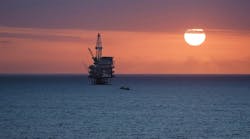Leonard Le BlancInformation flows and micro-sensing (acoustic, magnetic, gravitational, electronic, thermal) are continuing to replace dry holes, brute force, and heavy iron for the upstream petroleum industry. These new tools provide ways to detect, predict, and plan outcomes. They also help the industry use natural forces to neutralize undesireable conditions.
These revelations didn't come easy. Remember the distrust and "not invented here" syndrome. We no longer see the outright rejection of basic physics and chemistry research so prominent earlier in this decade. Stunning achievements in cost/time reduction have a way of pushing out old ways of thinking. Despite low oil prices, or rather because of them, this research train is not stopping anytime soon. The following are some of the areas where research is either underway or expected:
- Mobile mass: Deep mass in deep-draft and spar floating structures counters surface motions, so why not unlock that deep mass and pull it back to the surface (partial ballasting, reverse jacking) when transit is required?
- Gel-injection conductor: To combat shallow water flows in deepwater, why not pile-drive surface casing and periodically push a high density gel out through casing ports into the surrounding formation? Gel-to-casing friction makes driving tough, but minimizes upward water and sand flows.
- Screw-in piling: To simplify the installation of anchor-piles into the seabed, why not develop piles that can be installed by screwing them into the seabed with a momentum powerhead. Screw piles would be shorter, and a pile allowed to free-fall in deepwater could reach half of the depth needed.
- Mud lift: To increase the margin between the fracture gradient and formation pressures in deepwater, why not inject carbon dioxide or scrubbed engine exhaust into fluid returns at the seabed level to lift mud to the surface? Such a measure would not compromise well control or fluid evaluation.
- Production pulsing: Why not use production stream pulsing to convey downhole information to the surface, just as in drilling, in order to eliminate production string umbilicals? Pulses would be larger because of fluid-gas compressibility and repeated often. Power would be provided by a flow generator.
- Expandable junctions: To complement the use of cemented junctions downhole for multiple legs, why not use expandable steel junctions with pressure-activated mandrels and seals? The steel junctions could assist cement seals for higher pressure environments.
- Expandable proppants: Why not develop heat-expandable proppants to enhance hydraulic fracturing and reduce gravel packing requirements? The proppants could be injected cold into the smallest fractures and heated in place, where they would expand and remain in that state.
- Under-balanced control: Full-time or periodic under-balanced drilling can be an important tool for drilling in ultra-deepwater. To enhance control and safety, why not develop better downhole monitoring and quick intervention systems (slug injection, annulus block-and-bleed)?
- Real-time reservoir evaluation: Although invaluable in certain circumstances, coring and wireline trips delay evaluation. In conjunction with full-time or periodic under-balanced drilling, why not develop tools to evaluate reservoir performance in real time by extensive evaluation of annulus returns at the surface?
- Wellhead heat generation: To combat hydrate and wax formation in remote wellheads, why not use part of the well flow stream to generate heat at the wellhead? When the drive diminishes as the field matures, putting suction on the production stream would maintain flow power generation.
- Using engine exhaust: Not only can we use scrubbed engine exhaust to heat and re-pressurize the reservoir or inject it downhole to provide lift for production flows, but methods can be devised to use it in heat tracing to prevent hydrate and wax formation.
- Extending ERD: Why not fully harness the use of commandable (or automatic) traction devices entrained in the drillstring that make contact with the formation or casing in order to push the drill bit beyond current extended reach distances by reversing the action to reduce derrick size and make use of hydraulic lift and rotating systems.
- Long-range formation sensing: With the constant halfing of space required for microprocessors, why not harness micro-versions of surface seismic acoustics for use in the drillstring to evaluate formation geology and contents hundreds of feet from the borehole, not just the 5-8 ft we are obtaining at present.
Copyright 1998 Oil & Gas Journal. All Rights Reserved.




